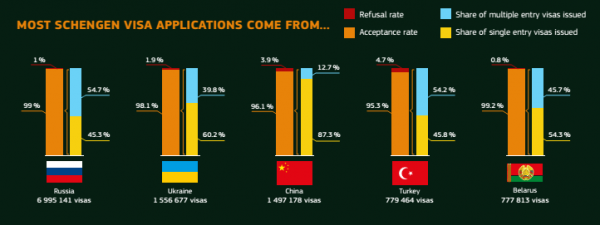Belarus: National Identity and Schengen Visas
Understanding the nuances of ethnic and national identity in faraway countries is arguably the Achilles’s heel of Western foreign policy making. This is regrettable considering that such nuances have powerful influence on international crises and on shaping their outcomes. This was the case in Iraq, and this is now the case in Ukraine. The rule of thumb is that any external provocation only achieves its conflict-inciting goals when cracks in the monolith are alreaady there. As acting president of Ukraine Olexander Turchynov noted, “Russian intelligence received a task to destabilize the situation in many regions [of Ukraine]—in the south, east and the center; but the actual results were achieved only in the east, in Donetsk and Luhansk oblasts” (http://www.svaboda.org/content/article/25385576.html).
It is little wonder, then, that the events in Ukraine have greatly intensified debates over national identity in nearby Belarus. The extent to which Belarus may be vulnerable to external provocation seems to be the underlying refrain of the entire debate. According to Yury Drakakhrust from the Belarusian Service of Radio Liberty, Belarus is more united than it is given credit for. First, for quite some time, Belarus was the only post-Soviet country with positive net migration from each and every other post-Soviet country. The migrants heading to Belarus have been, for the most part, ethnic Belarusians who had previously migrated elsewhere. Second, since 1991, in rallies within Belarus, Russian flags have never been used. This is quite different from what has been the case in Crimea or Donbas. Third, in Belarus, nobody ever suggested ridding the country of certain regions for the sake of national unity, whereas in Ukraine such an idea was first floated four years prior to Maidan by Yury Andrukhovich, a prose writer and public intellectual. In fact, in Belarus, an attempt to develop a sub-national identity in Polessye (in the south), undertaken in the early 1990s, has fizzled out (http://www.svaboda.org/content/article/25385576.html).
But even Drakakhrust claims that Belarus lacks the usual marker of identity: attachment to national language. Indeed, a Belarusian State University student majoring in history, referred to only as Lisa, recently conducted an experiment published in the Belarusian media. Accompanied by a representative from Tut.by, the most widely accessed non-government internet news portal, she visited a department store in downtown Minsk, a bank, a café and a sporting center, and she simply struck up conversations with passersby, always using Belarusian. The task of the experiment was to monitor the people’s reaction (http://news.tut.by/society/396796.html). “When you begin a conversation in Belarusian,” says Lisa, “you have to understand that you attract keen attention. If you are ready for that, there is no problem. But when you do not feel good or do not like how you look and, therefore, you do not want the attention of half of all the customers in a store fixated on you, then it is so much easier to speak Russian.” Although it appeared that none of the interlocutors actually became angry when approached in Belarusian, the very fact that the entire endeavor is referred to as an experiment shows that speaking Belarusian in the capital of Belarus is a major deviation from the accepted norm.
Yet, another aspect of identity is an attachment to national symbols. In Belarus, from 1992 to 1995, the white-red-white flag, symbolizing the legacy of the Grand Duchy of Lithuania, was official. But after the 1995 referendum under newly elected President Alyaksandr Lukashenka, it was replaced by the green-red flag, much resembling the flag of Soviet Belarus. Since 1995, the opposition has been loyal to the white-red-white flag, whereas the government and much of the population adheres the green-red one. At a roundtable discussion in May 2014, organized by the Speak-the-Truth campaign, an opposition movement headed by Uladzimer Neklyaev, the case of Ruslan Veremei was discussed. This person participated in the opposition rally on March 25, 2014, commemorating the anniversary of the Belarusian People’s Republic (an entity that existed for several months in 1918 under German military occupation and is glorified by the opposition as the first genuinely Belarusian state). Veremei came to this rally carrying two flags, a red-green and a white-red-white one, and many participants of the rally rebuked him for involving the official flag. Veremei is adamant that the existing schism on symbols is dangerous for the country. Andrei Dmitriev, one of the Speak-the-Truth campaign leaders, agrees—a still rare but promising phenomenon in Belarus (http://naviny.by/rubrics/society/2014/05/14/ic_articles_116_185496/)
Responding to an aggressively Russophile stance that denies existence to Belarusian as well as Ukrainian identity (see EDM, May 14), Alexei Dzermant from the Citadel Project opines that such views are integral to Russian ethnic nationalism of the White Guard type. “Just like in Ukraine, where the adherents of Ukrainian nationalism deny a separate identity to the denizens of eastern Ukraine (sic) and call them disparaging names […], likewise the Russian White Guard nationalists believe that Ukrainians and Belarusians en masse are not worthy of acceptance as self-styled people” (http://www.cytadel.org/articles/na-frontakh-informatsionnoj-vojny-ataka-na-belarus). The overarching point of Dzermant’s essay—to argue that it is possible to stand on the side of Russia and yet still be different from it—is symptomatic of the concerns many politically active Belarusians have these days.
Against the backdrop of such concerns, it is illuminating that for the fourth year in a row, Belarus remains the world leader in terms of the number of Schengen visas awarded per 1,000 residents. In 2013, this number for Belarus was 80; for Russia it was just 48, and for Ukraine 34 (http://naviny.by/rubrics/eu/2014/04/08/ic_articles_627_185156/). More than half of the visas issued to Belarusians were multi-entry. Belarusians, then, seem to be welcomed by the European Union, despite Europe’s policy of sanctions and notwithstanding an indistinct Belarusian national identity. If anything, this bodes well for Belarus.
Grigory Ioffe, The Jamestown Foundation

 EU visa statistics for 2013
EU visa statistics for 2013





















